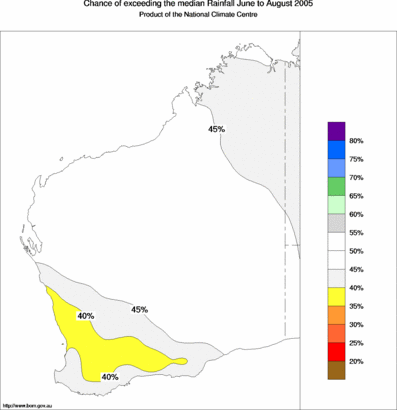| WA Seasonal Rainfall Outlook: probabilities for Winter 2005, issued 17th May 2005 | |
Reduced winter rainfall more likely in southwest WAThere is a moderate shift in the odds towards below average winter rainfall across much of southwest WA, the Bureau of Meteorology announced today. However, on a cautionary note, the skill of the outlook method is generally low (see below) in this part of WA, so this outlook should be used with caution. The pattern of winter rainfall odds is a result of above average temperatures in both the Pacific and Indian Oceans. Across southwest WA and southeastern Australia, the warm oceans have a reinforcing effect with the odds tilted in favour of a drier than average winter. However, across southern Queensland and northern NSW, the effects from the two oceans tend to cancel each other, with drier conditions promoted by the warm Pacific and wetter conditions by the warm Indian. 
So for the June to August period, the chances of above median rainfall are between 35 and 40% over much of the southwest corner of WA (see map). This means that below average falls have a 60 to 65% chance of occurring. So in years with ocean patterns like the current, about six winters out of ten are expected to be drier than average in this part of the State, with about four out of ten being wetter. For the rest of WA, the chances of accumulating at least average rain during winter are between 40 and 50%. It should be remembered though, that parts of far northern WA are seasonally dry in winter, and significant falls of rain are uncommon. Outlook confidence is related to the influence of Pacific and Indian Ocean temperatures on seasonal rainfall. During winter, history shows this influence to be mainly weakly or very weakly consistent over the southern two-thirds of WA, and moderate in patches across the Kimberley (see background information). The Southern Oscillation Index (SOI) has shown a high level of volatility recently with values of –11, zero and –29 for April, March and February respectively. The approximate SOI for the 30 days ending 14th May was –10. Low SOI values and warming in the Pacific Ocean over the past three months have increased the chances of an El Niño developing in 2005. However, it is still too early to predict what might happen in the Pacific, with any confidence. For routine updates and comprehensive discussion on the latest data relating to El Niño, together with details on what the phenomenon is and how it has affected Australia in the past, see the ENSO Wrap-Up. | |
Click on the map above for a larger version of the map. Use the reload/refresh button to ensure the latest forecast map is displayed. | |
| More information on this outlook is available from 9.00am to 5.00pm (WST) Monday to Friday by contacting the Climate and Consultancy section in the Bureau's Perth Office: (08) 9263 2222. | |
THE NEXT ISSUE OF THE SEASONAL OUTLOOK IS EXPECTED BY 17th JUNE 2005 Corresponding temperature outlook | |
Background Information
|









